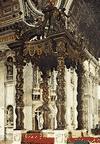- baldachin
-
—baldachined, adj./bal"deuh kin, bawl"-/, n.1. Also, baudekin. Textiles. a silk brocade interwoven with gold or silver threads, used chiefly for ceremonial purposes.2. Archit. a permanent ornamental canopy, as above a freestanding altar or throne.3. a portable canopy carried in religious processions.[1250-1300; earlier baldakin < ML baldakinus < It baldacchino, equiv. to Baldacc(o) Baghdad (famous as a source of silk brocades) + -ino -INE1]
* * *
Freestanding canopy of stone, wood, or metal over an altar or tomb.The Italian term baldacchino originally referred to brocaded material from Baghdad hung as a canopy over an altar or throne. The characteristic architectural form consists of four columns supporting entablatures, which carry miniature colonnades topped by a pyramidal or gabled roof. Gian Lorenzo Bernini's famous bronze baldachin (1624–33) stands at St. Peter's Basilica in Rome. Baldachin, St. Peter's, Vatican City, by Gian Lorenzo Bernini, 1624–33SCALAArt Resource/EB Inc.
Baldachin, St. Peter's, Vatican City, by Gian Lorenzo Bernini, 1624–33SCALAArt Resource/EB Inc.* * *
in architecture, the canopy over an altar or tomb, supported on columns, especially when freestanding and disconnected from any enclosing wall. The term originates from the Spanish baldaquin, an elaborately brocaded material imported from Baghdad that was hung as a canopy over an altar or doorway. Later it came to stand for a freestanding canopy over an altar.Early examples of the baldachin are found in Ravenna and Rome. The characteristic form consists of four columns supporting entablatures, which carry miniature colonnades topped by a pyramidal or gabled roof. In Romanesque work, arches generally replaced the entablatures, and gables frequently topped the four sides, as is the case in the Church of San Ambrogio in Milan. Few baldachins of the Gothic period remain, and their use outside Italy seems to have been intermittent; there is, however, a rich Gothic example in the Sainte-Chapelle at Paris (1247–50), reconstructed by Eugène-Emmanuel Viollet-le-Duc in the 19th century. In the Renaissance the use of the baldachin became more common, and during the 17th century elaborate structures were built, probably as a result of the influence of the enormous bronze baldachin that Gian Lorenzo Bernini designed for the altar of St. Peter's in Rome.* * *
Universalium. 2010.
